Life as a Mother with 20 Personalities
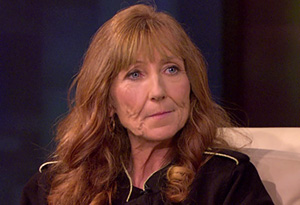
Oprah's 1990 interview with a woman named Truddi Chase remains one of the most unforgettable interviews in Oprah Show history. After suffering years of horrific sexual abuse that started when she was just 2 years old, Truddi's mind split into multiple personalities—92 in all.
Read Truddi's story.
Like Truddi, Kim Noble has been diagnosed with dissociative identity disorder, or DID—the preferred term for what used to be called multiple personality disorder. Kim is a 49-year-old mother who lives outside London and has 20 different personalities.
Among Kim's personalities are "Patricia," the primary personality; "Salome," a devout Catholic; "Judy," the personality who comes out at mealtimes and, despite Kim's slight frame, thinks she weighs more than 200 pounds; and "Ken," a depressed gay man.
Psychologists suspect Kim suffered severe trauma from sexual abuse as a young child that caused her mind to split into these multiple personalities. To communicate with "Patricia," "Judy," "Salome," "Ken" and the others, Kim's therapist sends emails to each of them. "We've got all different email addresses," Kim says. "They have their own password. So I've sat there trying to get in by thinking, 'What's the first word that comes into my head?' And trying to think what may be their password so I could actually look at their emails."
Read Truddi's story.
Like Truddi, Kim Noble has been diagnosed with dissociative identity disorder, or DID—the preferred term for what used to be called multiple personality disorder. Kim is a 49-year-old mother who lives outside London and has 20 different personalities.
Among Kim's personalities are "Patricia," the primary personality; "Salome," a devout Catholic; "Judy," the personality who comes out at mealtimes and, despite Kim's slight frame, thinks she weighs more than 200 pounds; and "Ken," a depressed gay man.
Psychologists suspect Kim suffered severe trauma from sexual abuse as a young child that caused her mind to split into these multiple personalities. To communicate with "Patricia," "Judy," "Salome," "Ken" and the others, Kim's therapist sends emails to each of them. "We've got all different email addresses," Kim says. "They have their own password. So I've sat there trying to get in by thinking, 'What's the first word that comes into my head?' And trying to think what may be their password so I could actually look at their emails."
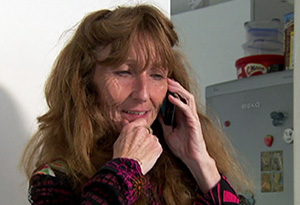
While Kim may exhibit two or three other personalities in a given day, her body is most often inhabited by "Patricia." "I'm the main personality that's around," she says. "I'm the one that keeps the house running, pays the bills and looks after Aimee, our daughter."
"Patricia" explains that she believes whoever Kim used to be is gone forever. "Things got too much for her, so she just disappeared and we have to take over the running of the body," she says. "I believe that we were protecting her. She disappeared and she's gone to sleep."
Living with DID means sharing a household—there are different clothes, closets and toothbrushes for each personality. "I mean, I suppose I don't blame them," "Patricia" says. "They don't want to use somebody else's toothbrushes."
Watch Kim transform into "Judy" at a meal.
"Patricia" explains that she believes whoever Kim used to be is gone forever. "Things got too much for her, so she just disappeared and we have to take over the running of the body," she says. "I believe that we were protecting her. She disappeared and she's gone to sleep."
Living with DID means sharing a household—there are different clothes, closets and toothbrushes for each personality. "I mean, I suppose I don't blame them," "Patricia" says. "They don't want to use somebody else's toothbrushes."
Watch Kim transform into "Judy" at a meal.

Photo: George Burns/Harpo Studios
Kim says whenever one personality inhabits her body, the rest are totally unaware of what is going on. Unlike how DID is represented in some TV shows or movies, her personalities do not, for instance, fight each other in her head.
"Patricia" says her situation isn't such where a single personality represents a specific mood (such as "anger" or "fear"). Instead, each of her 20 personalities has a full range of emotions. "They're different. I'm me, and they're them," she says. "Me, as 'Patricia,' I've got my days where I'm angry and in a bad mood and happy and sad. I'm completely whole as a person. And they are also."
"It sounds more crazy than it feels," she says.
"Patricia" says her situation isn't such where a single personality represents a specific mood (such as "anger" or "fear"). Instead, each of her 20 personalities has a full range of emotions. "They're different. I'm me, and they're them," she says. "Me, as 'Patricia,' I've got my days where I'm angry and in a bad mood and happy and sad. I'm completely whole as a person. And they are also."
"It sounds more crazy than it feels," she says.
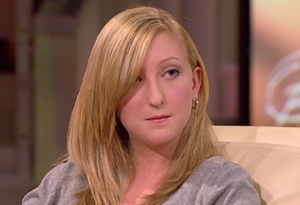
Like Truddi Chase, Kim is also a mother. When Kim's daughter, Aimee, celebrated her 13th birthday, many of the personalities gave her cards and bought presents.
Kim explains that "Dawn" was the personality who gave birth to Aimee. "Only one of us could be at the birth," she says. "We couldn't all be there because only one person can be in charge."
Aimee says being raised by a mom with 20 personalities is interesting but seems normal to her. "I haven't seen any different," she says. Aimee says she doesn't remember a time when she didn't know that her mother had DID, and Kim and her therapists don't hide anything from Aimee.
While Aimee knows all of Kim's personalities, she doesn't always immediately know which one is present at all times. "If they're new and I haven't seen them before or heard of them, then I would ask them who they are," she says. "That's how I get to build a relationship with them."
Kim explains that "Dawn" was the personality who gave birth to Aimee. "Only one of us could be at the birth," she says. "We couldn't all be there because only one person can be in charge."
Aimee says being raised by a mom with 20 personalities is interesting but seems normal to her. "I haven't seen any different," she says. Aimee says she doesn't remember a time when she didn't know that her mother had DID, and Kim and her therapists don't hide anything from Aimee.
While Aimee knows all of Kim's personalities, she doesn't always immediately know which one is present at all times. "If they're new and I haven't seen them before or heard of them, then I would ask them who they are," she says. "That's how I get to build a relationship with them."
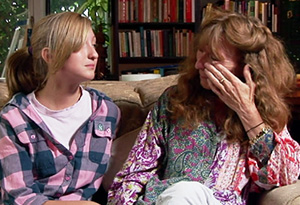
When "Dawn" arrives, she acts as if she's frozen in time and believes it is still 1997, the year Aimee was born.
"Dawn" doesn't realize Aimee is her daughter—she thinks she had a baby named Sky who was taken away at birth. Instead, she thinks Aimee is the daughter of a friend. "I think Aimee's good, and I'm very fond of her," she says. "But it's not the same as having your own."
This brings Aimee to tears. "I felt rejected," she says.
"Dawn" doesn't realize Aimee is her daughter—she thinks she had a baby named Sky who was taken away at birth. Instead, she thinks Aimee is the daughter of a friend. "I think Aimee's good, and I'm very fond of her," she says. "But it's not the same as having your own."
This brings Aimee to tears. "I felt rejected," she says.
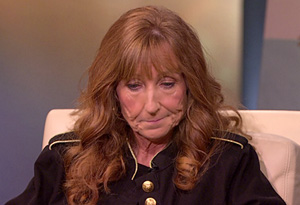
The personality that may hold the key to understanding what caused Kim's DID is "Ria Pratt," who thinks she is a 12-year-old girl.
Watch Ria Pratt's riveting explanation of how her childhood influences her art.
Back in the personality of "Patricia," Kim says watching "Ria Pratt" speak makes her sad. "But I don't have all those memories that she's got, so I'm hearing it like a third person," she says. "If I did, I probably would not be able to cope."
"Patricia" says she remembers parts of Kim's childhood, but never any abuse. "Not me. I haven't had any abuse," she says. "I'm lucky not to have had any."
Watch Ria Pratt's riveting explanation of how her childhood influences her art.
Back in the personality of "Patricia," Kim says watching "Ria Pratt" speak makes her sad. "But I don't have all those memories that she's got, so I'm hearing it like a third person," she says. "If I did, I probably would not be able to cope."
"Patricia" says she remembers parts of Kim's childhood, but never any abuse. "Not me. I haven't had any abuse," she says. "I'm lucky not to have had any."

Dr. Mary Sue Moore, a clinical psychologist who is an expert on trauma and the brain, says Kim's brain likely split into multiple personalities as a defense mechanism after a traumatic event.
While DID is a rare reaction to brain trauma, most people are familiar with the concept of repressing negative memories. "Some aspects of experience are too unbearable for a person to survive," she says. "When that happens, a part of the person can capture those memories and keep the rest of the person safe by holding onto those and isolating them. ... The body remembers it, but it's not pushed away—it simply holds onto it and doesn't share it."
While DID is a rare reaction to brain trauma, most people are familiar with the concept of repressing negative memories. "Some aspects of experience are too unbearable for a person to survive," she says. "When that happens, a part of the person can capture those memories and keep the rest of the person safe by holding onto those and isolating them. ... The body remembers it, but it's not pushed away—it simply holds onto it and doesn't share it."
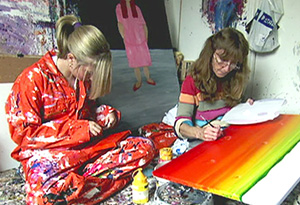
One of Kim's therapists encouraged the personalities to try painting. Not only has it helped Kim find some peace and stability through the routine, but she has even had her work exhibited throughout Europe.
Browse a gallery of Kim's art.
"Patricia" explains how each personality has its own unique artistic style. "'Missy' is a child personality. She paints in a very energetic way," she says. "'Abi' is another personality, and there's loneliness in her life."
Dr. Moore says it's no mistake that art has a therapeutic effect on Kim. "Memories are in a part of the brain that is also capable of producing artwork," she says. "Instead of coming out as words, the expression comes out in art."
What's it like talking to Kim? A producer of The Oprah Show answers questions about this interview.
Browse a gallery of Kim's art.
"Patricia" explains how each personality has its own unique artistic style. "'Missy' is a child personality. She paints in a very energetic way," she says. "'Abi' is another personality, and there's loneliness in her life."
Dr. Moore says it's no mistake that art has a therapeutic effect on Kim. "Memories are in a part of the brain that is also capable of producing artwork," she says. "Instead of coming out as words, the expression comes out in art."
What's it like talking to Kim? A producer of The Oprah Show answers questions about this interview.



